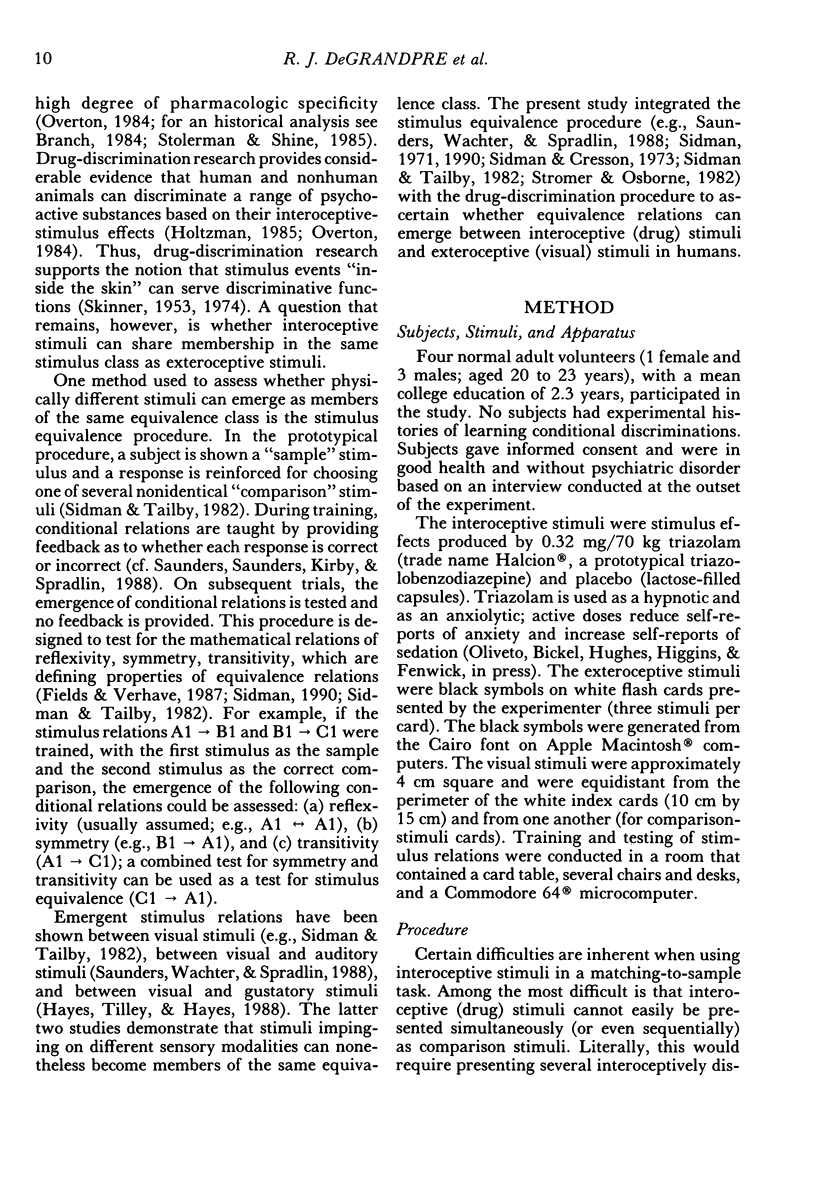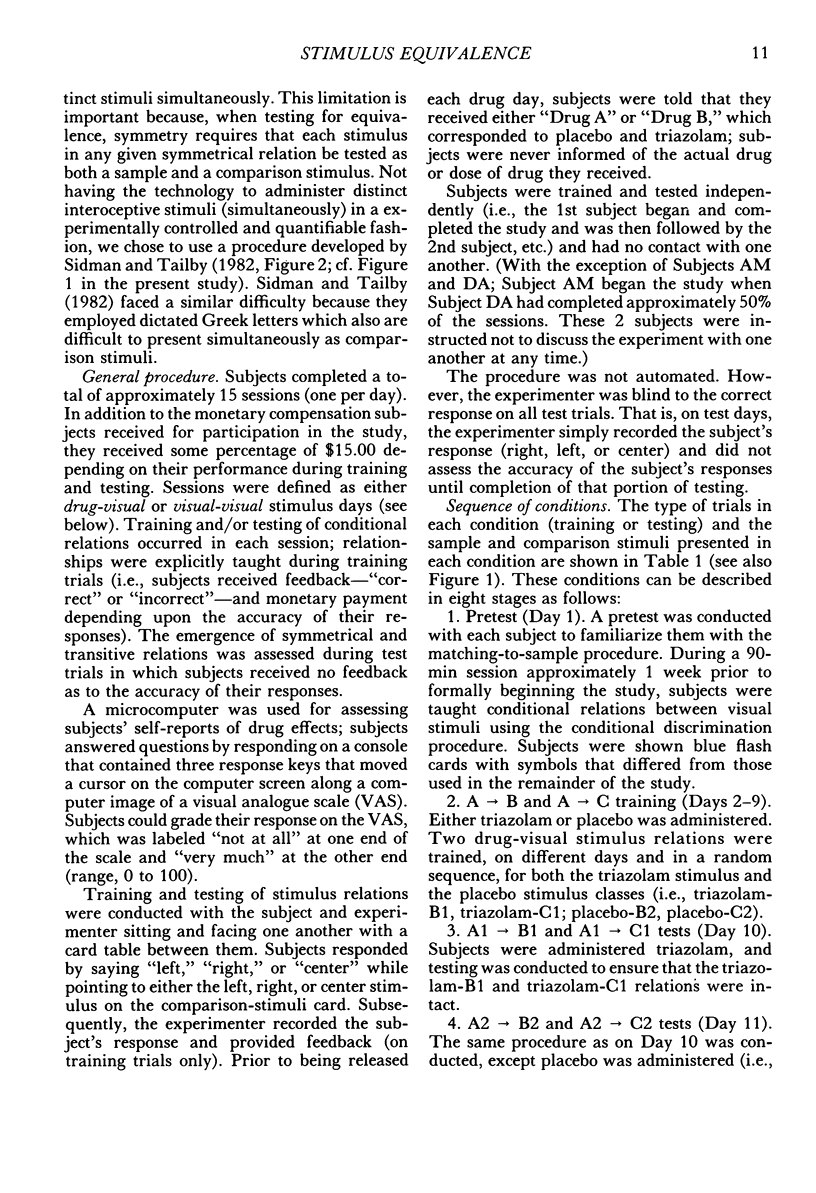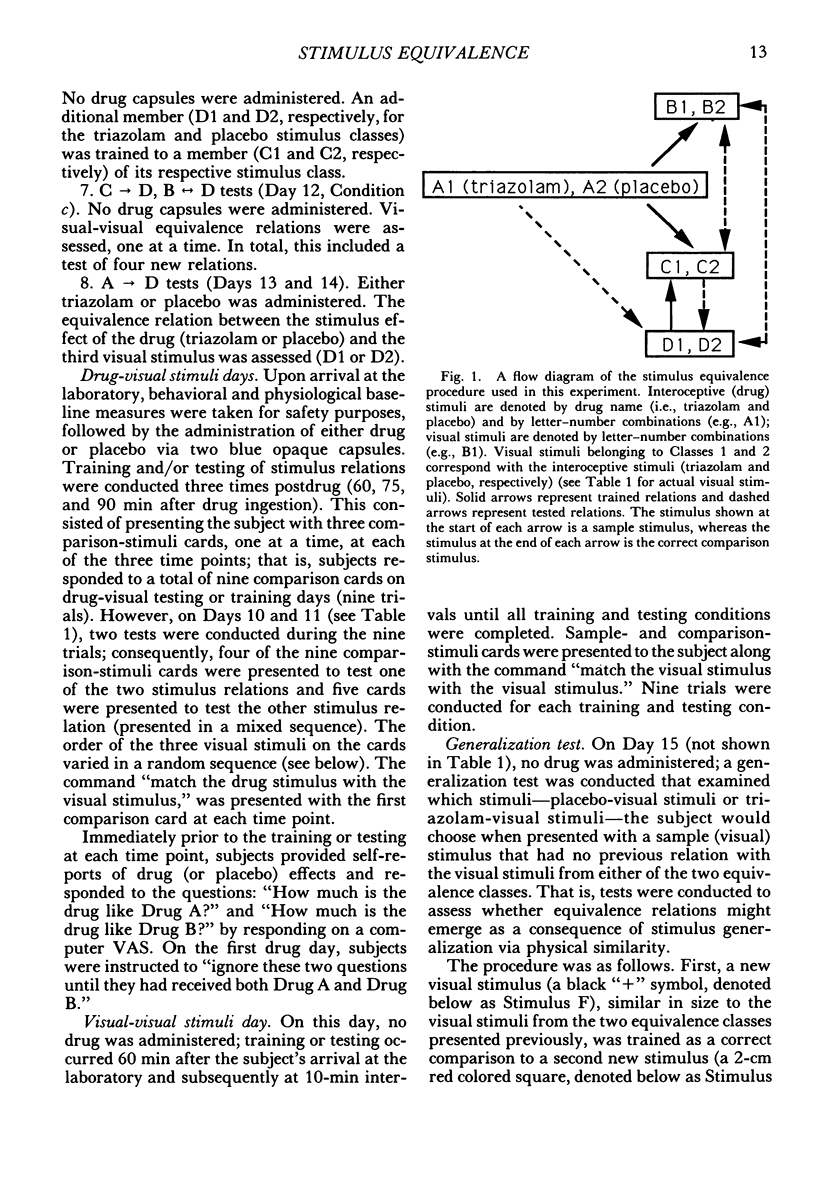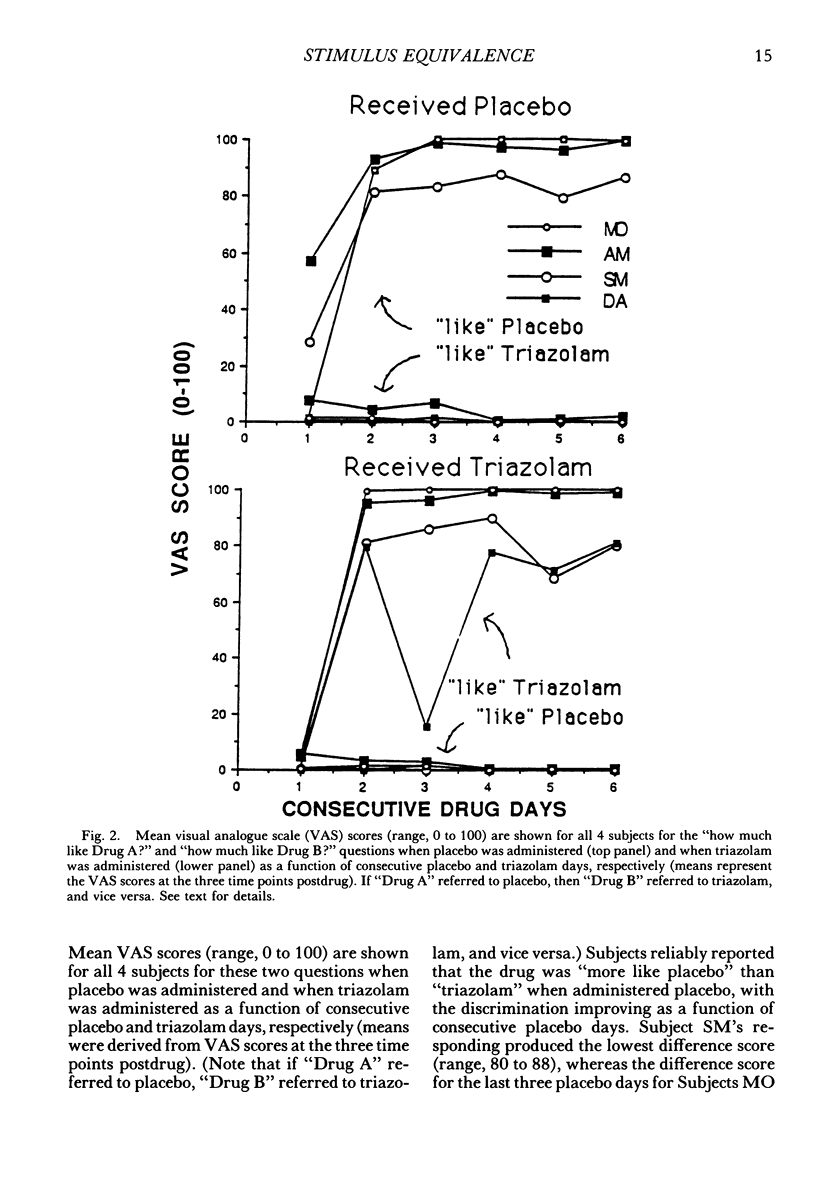Abstract
Conditional "if-then" relations between drug (interoceptive) stimuli and visual (exteroceptive) stimuli were taught to 4 normal humans. Interoceptive stimuli were the effects produced by 0.32 mg/70 kg triazolam (a prototypical benzodiazepine) and placebo (lactose-filled capsules); exteroceptive stimuli were black symbols on white flash cards. Following the training of the prerequisite conditional relations, tests of emergent relations were conducted between exteroceptive stimuli and between interoceptive and exteroceptive stimuli. Equivalence relations emerged immediately without explicit training for all 4 subjects. Accuracy of responding during the interoceptive-exteroceptive equivalence tests and subjects' self-reports showed consistent discrimination between the drug effects of triazolam and placebo. Finally, a generalization test assessed whether a novel visual stimulus presented in the context of the placebo (i.e., no drug) would generalize to visual stimuli belonging to the placebo stimulus class. All 3 subjects who completed this test reliably chose the visual stimuli belonging to the placebo class and not the visual stimuli belonging to the triazolam stimulus class. The development of equivalence relations between interoceptive and exteroceptive stimuli demonstrates that private and public stimulus events can emerge as members of the same equivalence class. Theoretical and clinical implications are discussed.
Full text
PDF









Selected References
These references are in PubMed. This may not be the complete list of references from this article.
- Barlow D. H., Vermilyea J., Blanchard E. B., Vermilyea B. B., Di Nardo P. A., Cerny J. A. The phenomenon of panic. J Abnorm Psychol. 1985 Aug;94(3):320–328. [PubMed] [Google Scholar]
- Bickel W. K., Bigelow G. E., Preston K. L., Liebson I. A. Opioid drug discrimination in humans: stability, specificity and relation to self-reported drug effect. J Pharmacol Exp Ther. 1989 Dec;251(3):1053–1063. [PubMed] [Google Scholar]
- Borkovec T. D., Wilkinson L., Folensbee R., Lerman C. Stimulus control applications to the treatment of worry. Behav Res Ther. 1983;21(3):247–251. doi: 10.1016/0005-7967(83)90206-1. [DOI] [PubMed] [Google Scholar]
- Chait L. D., Uhlenhuth E. H., Johanson C. E. The discriminative stimulus and subjective effects of d-amphetamine, phenmetrazine and fenfluramine in humans. Psychopharmacology (Berl) 1986;89(3):301–306. doi: 10.1007/BF00174364. [DOI] [PubMed] [Google Scholar]
- Fields L., Reeve K. F., Adams B. J., Verhave T. Stimulus generalization and equivalence classes: a model for natural categories. J Exp Anal Behav. 1991 May;55(3):305–312. doi: 10.1901/jeab.1991.55-305. [DOI] [PMC free article] [PubMed] [Google Scholar]
- Fields L., Verhave T. The structure of equivalence classes. J Exp Anal Behav. 1987 Sep;48(2):317–332. doi: 10.1901/jeab.1987.48-317. [DOI] [PMC free article] [PubMed] [Google Scholar]
- Lubinski D., Thompson T. An animal model of the interpersonal communication of interoceptive (private) states. J Exp Anal Behav. 1987 Jul;48(1):1–15. doi: 10.1901/jeab.1987.48-1. [DOI] [PMC free article] [PubMed] [Google Scholar]
- Margraf J., Taylor B., Ehlers A., Roth W. T., Agras W. S. Panic attacks in the natural environment. J Nerv Ment Dis. 1987 Sep;175(9):558–565. doi: 10.1097/00005053-198709000-00008. [DOI] [PubMed] [Google Scholar]
- O'Brien C. P., Childress A. R., McLellan A. T., Ehrman R., Ternes J. W. Types of conditioning found in drug-dependent humans. NIDA Res Monogr. 1988;84:44–61. [PubMed] [Google Scholar]
- O'Brien C. P. Experimental analysis of conditioning factors in human narcotic addiction. Pharmacol Rev. 1975 Dec;27(4):533–543. [PubMed] [Google Scholar]
- O'Brien C. P., Testa T., O'Brien T. J., Brady J. P., Wells B. Conditioned narcotic withdrawal in humans. Science. 1977 Mar 11;195(4282):1000–1002. doi: 10.1126/science.841320. [DOI] [PubMed] [Google Scholar]
- Preston K. L., Bigelow G. E., Bickel W., Liebson I. A. Three-choice drug discrimination in opioid-dependent humans: hydromorphone, naloxone and saline. J Pharmacol Exp Ther. 1987 Dec;243(3):1002–1009. [PubMed] [Google Scholar]
- Ruderman A. J. Dietary restraint: a theoretical and empirical review. Psychol Bull. 1986 Mar;99(2):247–262. [PubMed] [Google Scholar]
- Saunders R. R., Saunders K. J., Kirby K. C., Spradlin J. E. The merger and development of equivalence classes by unreinforced conditional selection of comparison stimuli. J Exp Anal Behav. 1988 Sep;50(2):145–162. doi: 10.1901/jeab.1988.50-145. [DOI] [PMC free article] [PubMed] [Google Scholar]
- Saunders R. R., Wachter J., Spradlin J. E. Establishing auditory stimulus control over an eight-member equivalence class via conditional discrimination procedures. J Exp Anal Behav. 1988 Jan;49(1):95–115. doi: 10.1901/jeab.1988.49-95. [DOI] [PMC free article] [PubMed] [Google Scholar]
- Sidman M., Cresson O., Jr Reading and crossmodal transfer of stimulus equivalences in severe retardation. Am J Ment Defic. 1973 Mar;77(5):515–523. [PubMed] [Google Scholar]
- Sidman M. Reading and auditory-visual equivalences. J Speech Hear Res. 1971 Mar;14(1):5–13. doi: 10.1044/jshr.1401.05. [DOI] [PubMed] [Google Scholar]
- Sidman M., Tailby W. Conditional discrimination vs. matching to sample: an expansion of the testing paradigm. J Exp Anal Behav. 1982 Jan;37(1):5–22. doi: 10.1901/jeab.1982.37-5. [DOI] [PMC free article] [PubMed] [Google Scholar]
- Siegel S. Tolerance to the hyperthermic effect of morphine in the rat is a learned response. J Comp Physiol Psychol. 1978 Dec;92(6):1137–1149. doi: 10.1037/h0077525. [DOI] [PubMed] [Google Scholar]
- Stolerman I. P., Shine P. J. Trends in drug discrimination research analysed with a cross-indexed bibliography, 1982-1983. Psychopharmacology (Berl) 1985;86(1-2):1–11. doi: 10.1007/BF00431677. [DOI] [PubMed] [Google Scholar]
- Street L. L., Craske M. G., Barlow D. H. Sensations, cognitions and the perception of cues associated with expected and unexpected panic attacks. Behav Res Ther. 1989;27(2):189–198. doi: 10.1016/0005-7967(89)90078-8. [DOI] [PubMed] [Google Scholar]
- Stromer R., Osborne J. G. Control of adolescents' arbitrary matching-to-sample by positive and negative stimulus relations. J Exp Anal Behav. 1982 May;37(3):329–348. doi: 10.1901/jeab.1982.37-329. [DOI] [PMC free article] [PubMed] [Google Scholar]
- Verduyn C. M., Stores G., Missen A. A survey of mothers' impressions of seizure precipitants in children with epilepsy. Epilepsia. 1988 May-Jun;29(3):251–255. doi: 10.1111/j.1528-1157.1988.tb03714.x. [DOI] [PubMed] [Google Scholar]


